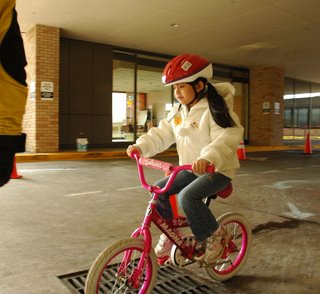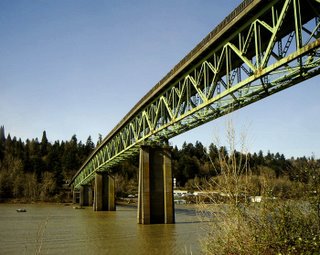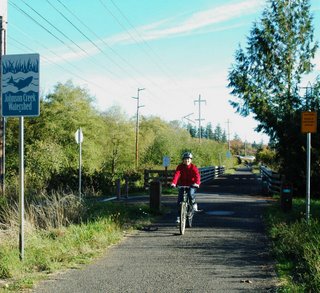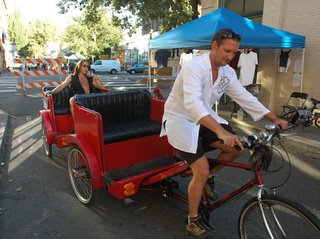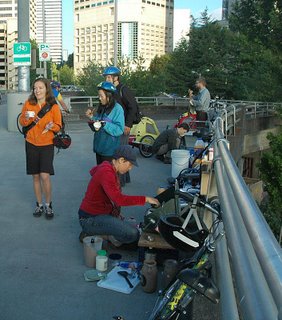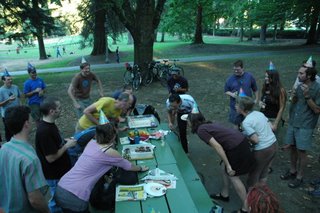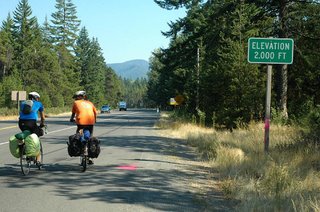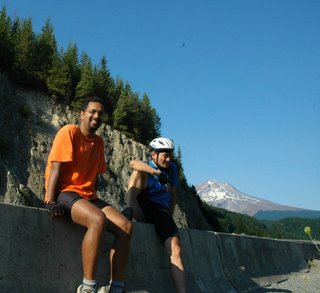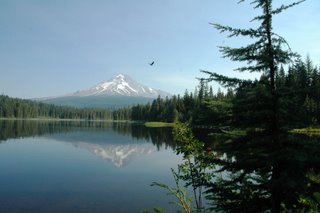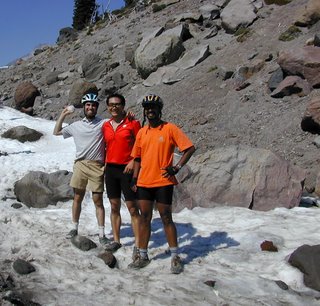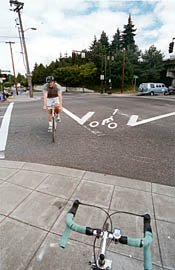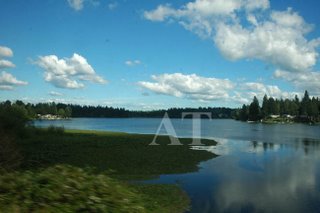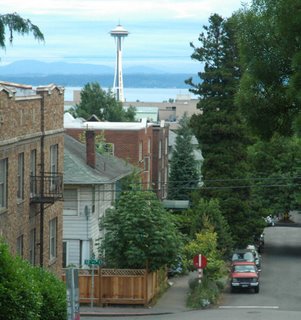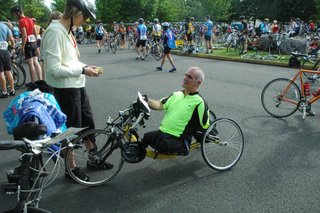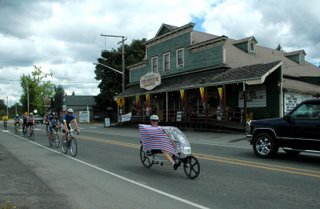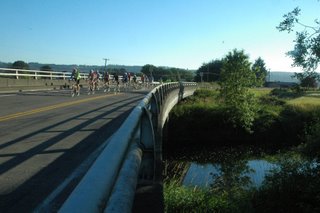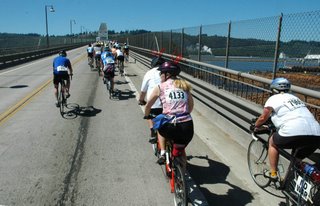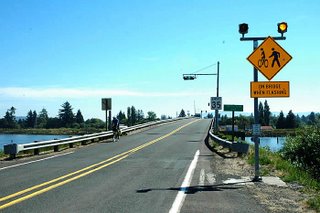
The Exchange Cycle Tours is currently traveling on it's most impressive Oregon Coast trip. They are traveling the entire Oregon Coast, and I was privilaged enough to join them on the first leg of the journey in Astoria. We had a
good sized group of 5 people including Steve, Jack, Ryan and Larry (who owns Bad Boys Bike Shop). Once our bikes were loaded up, we took off across
Miles crossing which was a great deal safer than
Young's Bay Bridge (which is not recommended).
We then traveled through some nice coastal floodplains before taking a visit to the Fort Clatsop state Park. After mistakenly stopping at the parking lot, we headed up to the park itself which was very nice and clean looking.
The fort looked incredibly good considering the recent fire. It was almost completely rebuilt, and stood as an exemple of the real American spirit (which has recently been basterdized for political gain). These were the
actual conditions our pioneers lived in, and their simple existance examplified a number of lifestyle decisions which modern Americans could embrace to reduce the
hardships which will otherwise be endured by the next generation (such as a
minimal building footprint). But I digress.
We left along Louis & Clark Rd and traveled south along the same route that the
Hood to Coast convoy was using. I would normally have been very unhappy with the large amount of traffic which we were subjected to. However what stood out in my experience, was that every single vehicle passed us at least a
meter of space (1). Given that the most frustrating aspect of traffic is the uncertainty in a driver's ability to safely pass, this was a singular experience for me. I've never traveled in heavy traffic without having to keep a sharp eye on other vehicles. Add to that many of the hilarious
logos that some vans were sporting ("running from our kids", "coastal whine") and it was about as pleasant as traveling down
Clinton.
While cycling along this road, we met up with
Daryl who was cycling along the same road. Daryl told us of his previous feet to cycle the entire Oregon coastal route in one day. It sounded like an incredible journey, and he certainly looked like he was in shape enough to do so again. This is one of the many reasons why I love cycling so much. Like jogging, the lack of enclosure allows for great sharing with other people who might have otherwise remained strangers.
When we rejoined Hwy 101 the regular vacationing traffic resumed. As we headed into Seaside, the traffic was backed up for about 2 miles. This often brings me to wonder what people think as we pass. Do they feel envy, awe, jealousy? Do they feel gratitude that we on our bikes are reducing the
traffic problem? Unfortunately I have little faith that they are aware of such benefits.
We stopped in for lunch at Seaside and I chatted with the shop owner about how the Hood to Coast event affects the city. Was the increased traffic more problematic? Or was it offset by the money that the event brings. She seemed to feel quite positive that the benefits of the run and the business it brings overshadows the traffic problem. Other people who I talked to ranged from neutral to negative. Apparently there's no consensus on the matter.
After a great lunch, we picked up some maps and headed out of Seaside (past more traffic) and out along the marvelous coastal scenery. Many of the areas we passed through reminded me of the
Palos Verdes coast. We passed some great locations, like
Hug Point and Pizza Cove. I got a fun shot of
Haystack Rock in Cannon Beach before we headed back into the hills. At the Rockwork lookout we took some
group shots and the panorama was
amazing. No photograph could capture the awesome scale of the mountains we had surmounted.
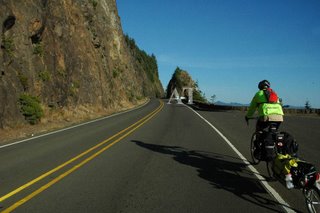
We continued on through some great mountain country and everyone trooped through the hills well despite many comments of being out of shape. Touring is not something that a person has to be at a high fitness level for.
Bike touring is an activity which builds strength over time, and encourages slow inhalation of the
countryside.We headed into Nehalem towards evening with plenty of time to get set up for the night. The road to the campsite was very depressing. A huge section of forestland had been demolished in order to expand the local dump. The whole area had been devastated. We even had a small spill on one of the sharp turns coming towards the park. There was however some contrast within the
Nehalem Bay State Park where we traveled through a marvelous 8 meter wide
road through the woods. It was similar to
the roads around Mt Hood in peacefulness and beauty. We checked in and got to our campsite where everyone set up their tent and got things laid out. I was so excited to see other cycling campers there that I made some attempts to socialize with the other campers. The
campsites were great in that there was a large sandbox for each tent. It was incredibly comfy to lay on.
Our group then went out to dinner at Wandas, a great local restaurant which was obviously reaping the benefits of the thriving tourist market. The food was great and I had a good time.
When we returned, we saw
Gary who was riding his beautiful recumbent south from Astoria. He'd been riding along Hwy 101 with us for a stretch, and it was great to see that he'd made it nicely. The next morning I waited for everyone to pack up and looked on in amazement at what's considered '
normal' recreation. Apparently it involves no less than one vehicle, a trailer, and possibly a motorhome. I wonder how many millions of dollars our state parks could save (for use protecting wild areas and building trails) if the money didn't have to be spent on
asphalt and concrete. I talked a bit with Gary about
recumbents and the 'tecky' aspects of bicycling.
When we got to
Wanda's later that morning, we found that Gary had saved us a table at the overpacked restaurant. This was a perfect example of how wonderful life can be when people have a lifestyle which is amenible to socializing.
For breakfast I had french toast with
fresh blackberries. The important point is that the berries were my harvest from the bushes that grew along the path. Americans have so much to benefit from the huge amount of
edible flora that grows all over.
We traveled out of Nehalem on on Rt 101 and saw the most
beautiful scenery of the trip on this stretch of road. As soon as we left town the views became
incredible. Even with the weather changing from
foggy to
clear in a matter of minutes, there was always something to look at.
We stopped in Garibaldi and saw a
museum before heading on to Tillamook. Here we stopped at the
cheese factory and saw the amazing plethora of
yummy foods produced right here in Oregon. After the tour I departed company with the group and headed on along Rt 6 back to Portland. Thanks to
Jeff Smith (of
PDOT fame) I had pre-printed maps of the
route back to Forest Grove (and public transit access).
The roads through the coastal range provide an amazing contrast. The scenery is undoubtedly the best scenery in the area, with thick forests, undulating hillsides, and
gushing rivers. However the roads are thick with
motorhomes, and trucks pulling ATVs during the most beautiful time of year. Near the summit I stopped at a perfect little alcove with a
waterfall providing the most delicious water that I've ever tasted.
With time running short, I pushed my legs hard to reach west Portland before nightfall. So it was with huge relief that I passed the summit at 450 meters and headed downhill to Forest Grove. I stopped quickly for directions and some food from a local store, then continued east through some
gorgeous farm country. Providence shined upon me when I found a great little niche by a field with some overgrown orchards. I had a great desert of blackberries and watched twilight fade into a marvelous star-filled sky.
The Oregon Coast is definately a great scenic destination, but you want to search out the less vehicle-centric locations in order to truly enjoy it's majesty.
1 I use metric measurements to encourage understanding of international units of measure
